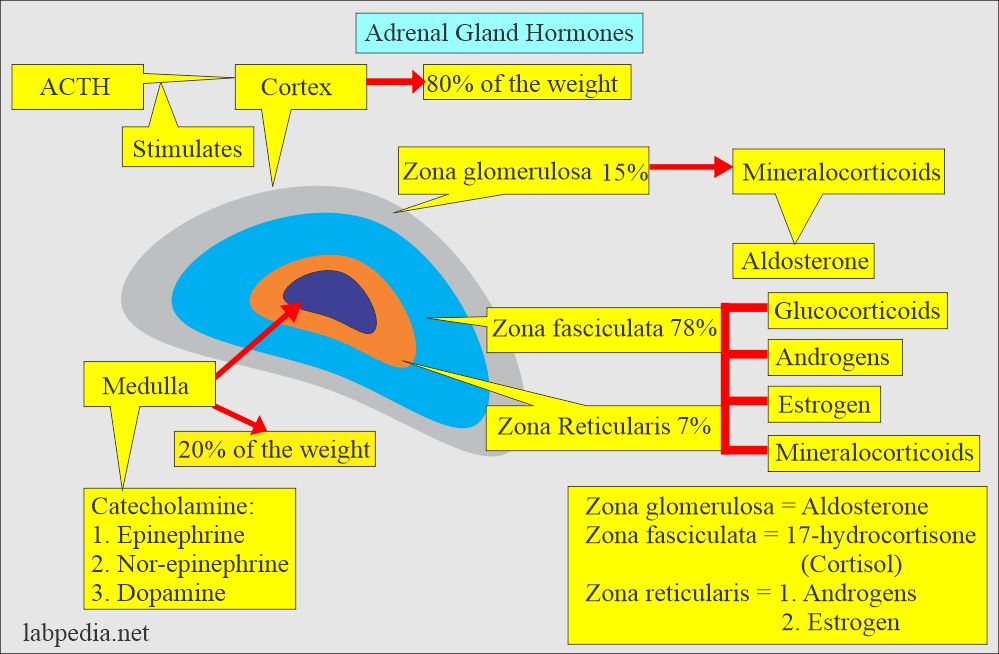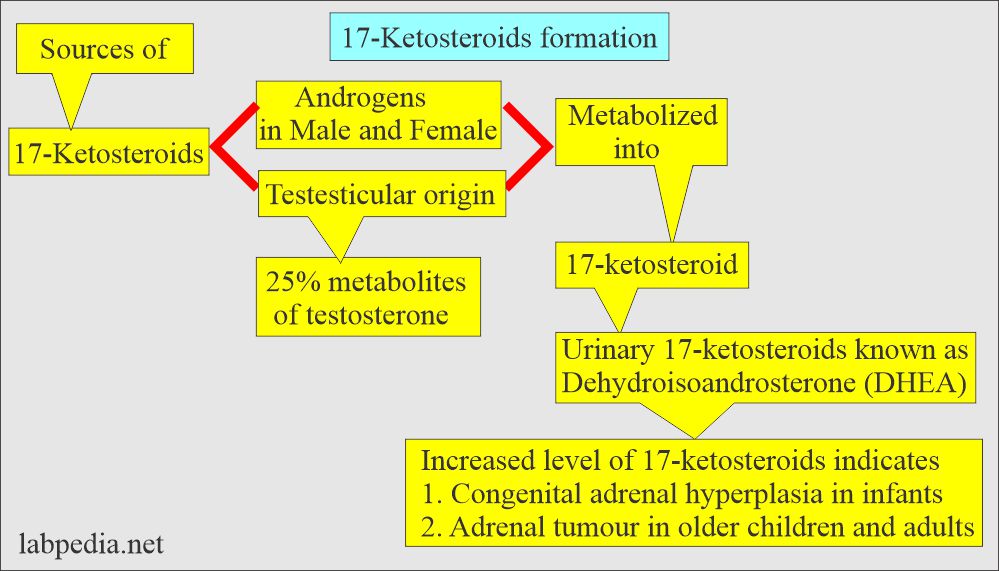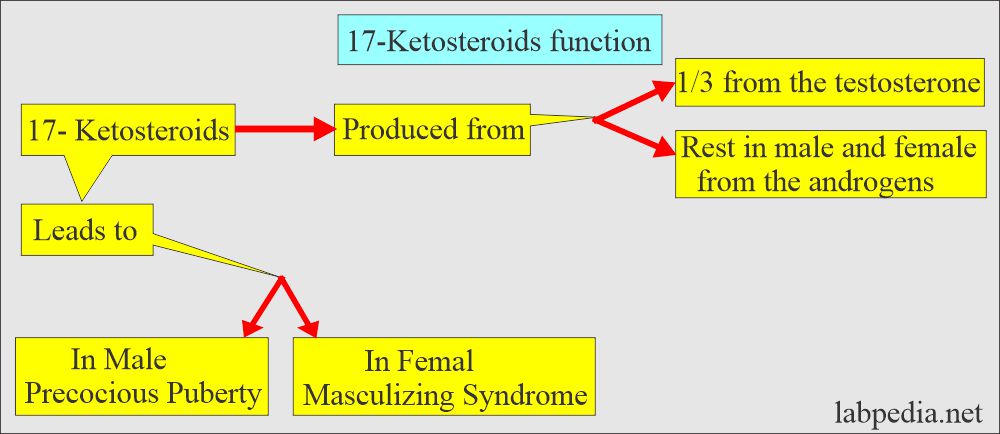Urine 17-Ketosteroids Level (24 hours urine)
Urine 17-Ketosteroids (24 hours urine)
What sample is needed for Urine 17-ketosteroids?
- A 24-hour urine sample was collected in a container containing 6 ml of HCL acid or one gram of boric acid.
- When starting the collection, discard the first sample and collect all the samples, including the last sample, when 24 hours are completed.
- A urine sample will be stable for 2 weeks at 4 °C.
- For a longer period, keep at -20 °C.
What are the Indications for Urine 17-ketosteroids?
- This is done to assess the following:
- The adrenal cortex function.
- To evaluate and monitor adrenal hyperplasia.
- To assess and monitor the adrenal tumors.
- To determine the hairs on the faces of females.
What are the Precautions for Urine 17-ketosteroids?
- Stop the medicines that interfere with the result like:
- Diuretics
- Aspirin
- Antibiotics
- Hormone therapy like Estrogen.
- Stop birth control medication.
How will you define 17-Ketsteroids?
- 17-Ketosteroids are a group of steroid hormones that are metabolic byproducts of adrenal and gonadal steroids.
- They are excreted in urine and include compounds like androsterone, dehydroepiandrosterone (DHEA), and etiocholanolone.
- 17-Ketosteroids are not metabolites of cortisone or hydrocortisone.
How will you discuss the pathophysiology of 17-ketosteroids?
- Adrenal glands lie at the upper pole of the kidneys.
- It is pyramidal in shape.
- It measures approximately 2 to 3 cm in width, 4 to 6 cm long, and 1 cm thick.
- Its weight is 4 grams, irrespective of age, weight, and sex.
- Each gland consists of an outer yellow cortex and a grey inner medulla.
- To understand the formation of 17-ketosteroids, we need to understand the functions of the adrenal gland, as shown in the following diagram.
- Androgens and testosterone are metabolized to 17-ketosteroid, the overall measure of androgen production.
- The main excretory metabolites of:
- Testosterone.
- Androstenedione.
- DHEA
- They are collectively called 17-ketosteroids, which can be quantitated in the urine.
- 17-Ketosteroids are measured in urine only.
- 17-ketosteroids are the metabolites of testosterone and another androgenic sex hormone.
- 17- Ketosteroid is the end product, dehydroepiandrosterone secreted in the urine.
What are the Sources of 17-Ketosteroids?
- In men:
- Roughly 1/3 is produced from the testosterone produced in the testes.
- Rest comes from other androgenic hormones produced in the adrenal cortex.
- In women and children:
- Almost all 17-ketosteroids are non-testosterone produced by the androgens in females and males.
- 17-Ketosteroids are not the metabolites of Cortisol, so they do not indicate cortisol production.
What is the presentation of increased 17-ketosteroid?
- Masculinizing syndrome in females.
- Precocious puberty in males.
What are the normal Urine 17-ketosteroids?
| Male | 10 to 25 mg /24 hours |
| Female | 6 to 15 mg /24 hours |
| After the age of 70 years | |
| Male | 3 to 12 mg / 24 hours |
| Female | 3 to 13 mg / 24 hours |
| Infants | <1.0 mg / 24 hours |
| 1 to 4 years | <2 mg / 24 hours |
| 10 to 12 years | 1 to 5 mg /24 hours |
| 14 to 16 years male | 3 to 13 mg/24 hours |
| 14 to 16 years female | 2 to 8 mg/24 hours |
What are the causes of increased 17-ketosteroids?
- Congenital adrenal hyperplasia.
- Pregnancy.
- Hyperpituitarism
- Testosterone-secreting or androgen-secreting tumors of:
- Ovaries.
- Testes
- Ectopic ACTH-secreting tumors.
- Administration of ACTH.
- Stein-Leventhal syndrome.
- Cushing’s syndrome.
What are the causes of decreased 17-ketosteroids?
- Severe stress.
- Severe infections.
- Debilitating diseases.
- Addison’s disease
- Castration
- Hypopituitarism
- Myxedema
- Nephrosis.
- Klinefelter’s syndrome.
- Chronic diseases.
What are the drugs that lead to a decrease in 17-ketosteroids?
- Birth control pills
- Estrogens
- Probenecid
- Reserpine
- Salicylates (prolonged use)
- Thiazide diuretics
- Birth control pills
- Estrogens
- Probenecid
- Reserpine
- Salicylates (prolonged use)
- Thiazide diuretics
Test value for the layman:
- The 17-ketosteroid test is done to find any abnormality of the adrenal gland.
- Advised if the female has hairs on the face.
Questions and answers:
Question 1: What is the significance of 17-Ketosteroids?
Question 2: How will you work for the hairs on the face of females?





I found useful site.
Thanks for the comments.
Thank you very much, this was really helpful.
Thanks for the encouraging remarks. God bless you.
I have found a couple of errors which if corrected will make it an excellent page.
Under Pathophysiology 2. “and this is the overall measure of glucocorticoids”, should say – and this is the overall measure of of androgen production – instead.
The same should be corrected in the diagram under 3.3.1.
Thanks for the suggestions and done.
It’s very useful and well explained
Thanks.